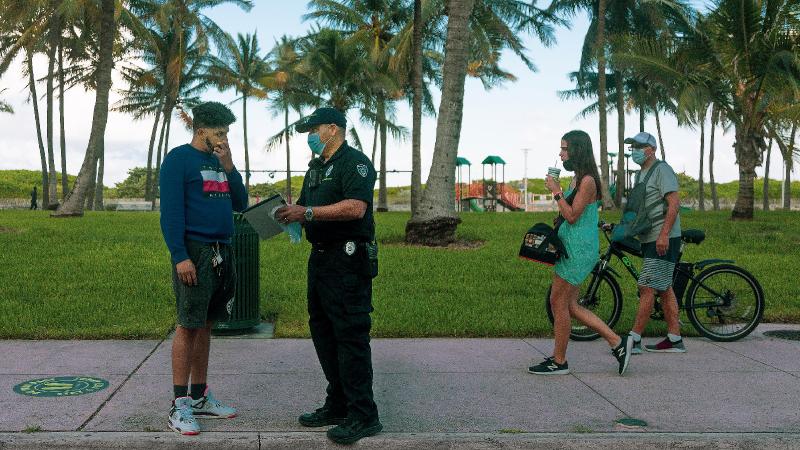A Misleading C.D.C. Number
By: David Leonhardt (The New York Times)


When facts are exaggerated to fulfill an overzealous and unrealistic benchmark then public doubts shouldn't be surprising. When should caution justify misinformation?
The claim is that erring on the side of caution (or protection) would seem to have few downsides. But that, too, is misinformation that ignores how erring on the side of caution has disrupted supply chains, created hardships, and turned us against each other. Wearing masks at all times has become a political litmus test for moral good; simply because the facts have been exaggerated.

When the Centers for Disease Control and Prevention released new guidelines last month for mask wearing, it announced that "less than 10 percent" of Covid-19 transmission was occurring outdoors. Media organizations repeated the statistic, and it quickly became a standard description of the frequency of outdoor transmission.
But the number is almost certainly misleading.
It appears to be based partly on a misclassification of some Covid transmission that actually took place in enclosed spaces (as I explain below). An even bigger issue is the extreme caution of C.D.C. officials, who picked a benchmark — 10 percent — so high that nobody could reasonably dispute it.
That benchmark "seems to be a huge exaggeration," as Dr. Muge Cevik, a virologist at the University of St. Andrews, said. In truth, the share of transmission that has occurred outdoors seems to be below 1 percent and may be below 0.1 percent, multiple epidemiologists told me. The rare outdoor transmission that has happened almost all seems to have involved crowded places or close conversation.
Saying that less than 10 percent of Covid transmission occurs outdoors is akin to saying that sharks attack fewer than 20,000 swimmers a year. (The actual worldwide number is around 150.) It's both true and deceiving.
This isn't just a gotcha math issue. It is an example of how the C.D.C. is struggling to communicate effectively, and leaving many people confused about what's truly risky. C.D.C. officials have placed such a high priority on caution that many Americans are bewildered by the agency's long list of recommendations. Zeynep Tufekci of the University of North Carolina, writing in The Atlantic, called those recommendations "simultaneously too timid and too complicated."
They continue to treat outdoor transmission as a major risk. The C.D.C. says that unvaccinated people should wear masks in most outdoor settings and vaccinated people should wear them at "large public venues"; summer camps should require children to wear masks virtually "at all times."
These recommendations would be more grounded in science if anywhere close to 10 percent of Covid transmission were occurring outdoors. But it is not. There is not a single documented Covid infection anywhere in the world from casual outdoor interactions, such as walking past someone on a street or eating at a nearby table.
Today's newsletter will be a bit longer than usual, so I can explain how the C.D.C. ended up promoting a misleading number.
The Singapore mystery
If you read the academic research that the C.D.C. has cited in defense of the 10 percent benchmark, you will notice something strange. A very large share of supposed cases of outdoor transmission have occurred in a single setting: construction sites in Singapore.
In one study, 95 of 10,926 worldwide instances of transmission are classified as outdoors; all 95 are from Singapore construction sites. In another study, four of 103 instances are classified as outdoors; again, all four are from Singapore construction sites.
This obviously doesn't make much sense. It instead appears to be a misunderstanding that resembles the childhood game of telephone, in which a message gets garbled as it passes from one person to the next.
The Singapore data originally comes from a government database there. That database does not categorize the construction-site cases as outdoor transmission, Yap Wei Qiang, a spokesman for the Ministry of Health, told my colleague Shashank Bengali. "We didn't classify it according to outdoors or indoors," Yap said. "It could have been workplace transmission where it happens outdoors at the site, or it could also have happened indoors within the construction site."
As Shashank did further reporting, he discovered reasons to think that many of the infections may have occurred indoors. At some of the individual construction sites where Covid spread — like a complex for the financial firm UBS and a skyscraper project called Project Glory — the concrete shells for the buildings were largely completed before the pandemic began. (This video of Project Glory was shot more than four months before Singapore's first reported Covid case.)
Because Singapore is hot year-round, the workers would have sought out the shade of enclosed spaces to hold meetings and eat lunch together, Alex Au of Transient Workers Count Too, an advocacy group, told Shashank. Electricians and plumbers would have worked in particularly close contact.
Are schools outdoors?
How, then, did the Singapore cases get classified as they did?
When academic researchers began collecting Covid data from around the world, many chose to define outdoors spaces very broadly. They deemed almost any setting that was a mix of outdoors and indoors to be outdoors.
"We had to settle on one classification for building sites," Quentin Leclerc, a French researcher and co-author of one of the papers analyzing Singapore, told me, "and ultimately decided on a conservative outdoor definition." Another paper, published in the Journal of Infection and Public Health, counted only two settings as indoors: "mass accommodation and residential facilities." It defined all of these settings as outdoors: "workplace, health care, education, social events, travel, catering, leisure and shopping."
I understand why the researchers preferred a broad definition. They wanted to avoid missing instances of outdoor transmission and mistakenly suggesting that the outdoors was safer than it really was. But the approach had a big downside. It meant that the researchers counted many instances of indoors transmission as outdoors.
And yet even with this approach, they found a minuscule share of total transmission to have occurred outdoors. In the paper with 95 supposedly outdoor cases from Singapore, those cases nonetheless made up less than 1 percent of the total. A study from Ireland, which seems to have been more precise about the definition of outdoors, put the share of such transmission at 0.1 percent. A study of 7,324 cases from China found a single instance of outdoor transmission, involving a conversation between two people.
"I'm sure it's possible for transmission to occur outdoors in the right circumstances," Dr. Aaron Richterman of the University of Pennsylvania told me, "but if we had to put a number on it, I would say much less than 1 percent."
Britain's scientific approach
I asked the C.D.C. how it could justify the 10 percent benchmark, and an official there sent this statement:
There are limited data on outdoor transmission. The data we do have supports the hypothesis that the risk of outdoor transmission is low. 10 percent is a conservative estimate from a recent systematic review of peer-reviewed papers. CDC cannot provide the specific risk level for every activity in every community and errs on the side of protection when it comes to recommending steps to protect health. It is important for people and communities to consider their own situations and risks and to take appropriate steps to protect their health.
Erring on the side of protection — by exaggerating the risks of outdoor transmission — may seem to have few downsides. But it has contributed to widespread public confusion about what really matters. Some Americans are ignoring the C.D.C.'s elaborate guidelines and ditching their masks, even indoors, while others continue to harass people who walk around outdoors without a mask.
All the while, the scientific evidence points to a conclusion that is much simpler than the C.D.C.'s message: Masks make a huge difference indoors and rarely matter outdoors.
The health authorities in Britain, notably, seem to have figured this out. They have been more aggressive about restricting indoor behavior, locking down many businesses again late last year and requiring masks indoors even as most of the country is vaccinated. Outdoors, however, masks remain rare.
It certainly doesn't seem to be causing problems. Since January, daily Covid deaths in Britain have declined more than 99 percent.



What else is the CDC exaggerating? When do these types of exaggerations become nothing more than fear mongering?
Why is the CDC so careless about it's credibility? It's like they are trying to teach people that it's guidelines bear no relation to reality and can be ignored..
At the end of the day, is there anyone who has screwed this pandemic up worse than the freaking CDC? No one has done as much damage to their credibility as they themselves have.
Another evolving Covid story and Fauci's CDC involvement with it.
From the article...
"So it should come as little surprise that Fauci and NIH Director Francis Collins wrote a loophole in the moratorium that allowed them to continue funding Daszak's work despite full knowledge of the risks. Unless the bat-borne RaTG13 really managed to mutate naturally into SARS-Cov-2, travel over 1,000 miles without infecting anyone along the way, and end up in a wet market that sold neither bats nor pangolins, then ... well, do the math"
Still too close to the election for this attempt to hijack the seed to have any traction. Right now the political expediency is still to blame Trump. As we get closer to the midterm election it will become more politically expedient to blame China. Biden will be forced to pivot to China before the midterms and that's when this story will become useful. It's looking doubtful that Fauci will politically survive the pandemic.
Good thing for him he's not a politician.
Which is irrelevant. Anthony Fauci is not protected from politics. Fauci has become a highly visible and politically controversial figure. As the pandemic recedes the government's response will be critiqued and will become fodder for political campaigns.
Fauci's days are numbered. It's going to become more politically expedient to force Fauci into retirement.
Anthony Fauci is not protected from politics
That's irrelevant, he is not a politician and I don 't think he's concerned with politics.
Fauci has become a highly visible and politically controversial figure.
This was not his doing. He's a scientist at the CDC. If politicians choose to treat him like a human pinata it's not his problem.
Fauci's days are numbered.
That's probably true but due more to the fact he's 80 years old, not political bickering. He's probably had his retirement date planned long before covid.